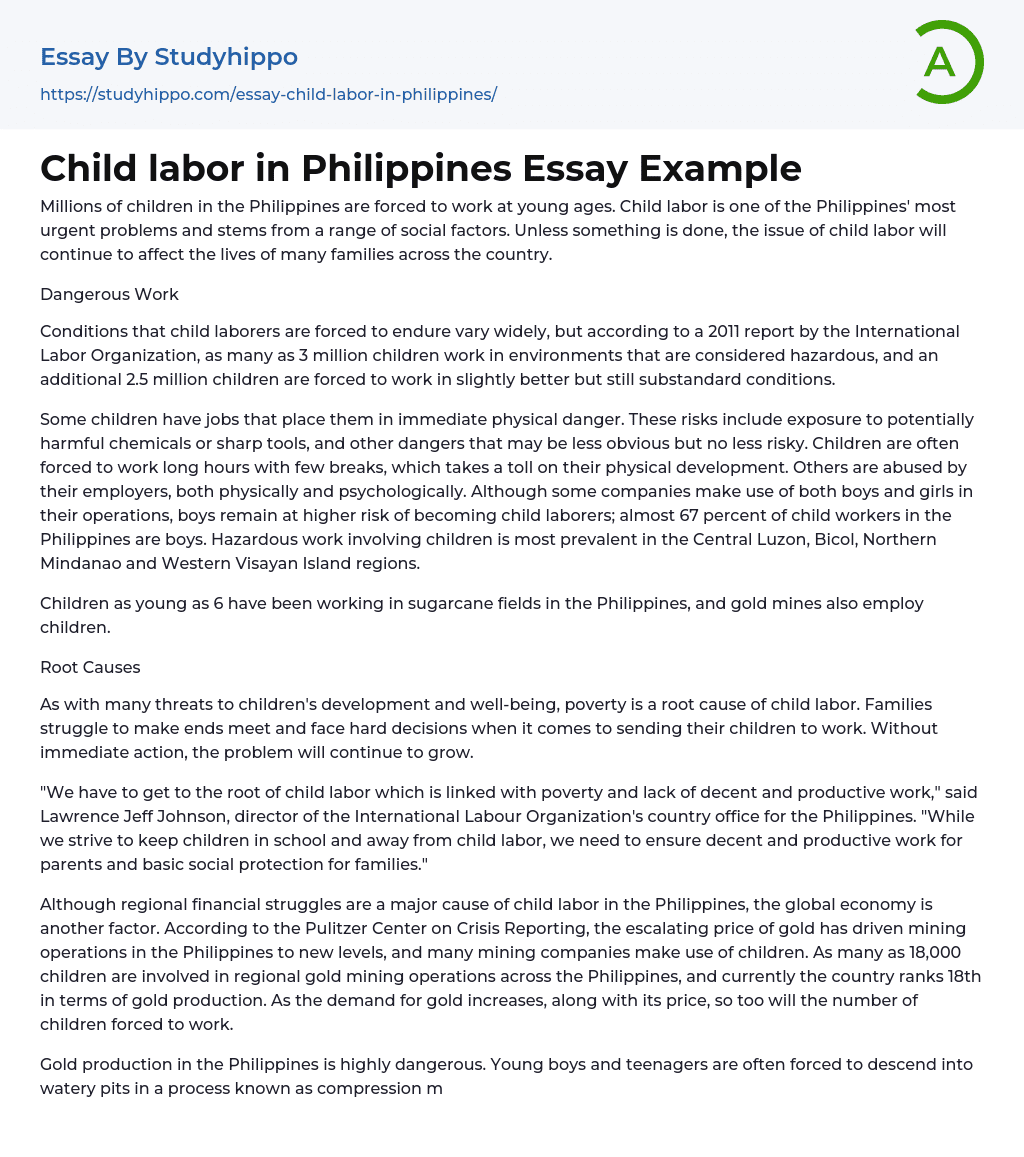Millions of children in the Philippines are forced to work at young ages. Child labor is one of the Philippines' most urgent problems and stems from a range of social factors. Unless something is done, the issue of child labor will continue to affect the lives of many families across the country.
Dangerous Work
Conditions that child laborers are forced to endure vary widely, but according to a 2011 report by the International Labor Organization, as many as 3 million children work in environments that are considered hazardous, and an additional 2.5 million children are forced to work in slightly better but still substandard conditions.
Some children have jobs that place them in immediate physical danger. These risks include exposure to potentially harmful chemicals or sharp tools, and other dangers
...that may be less obvious but no less risky. Children are often forced to work long hours with few breaks, which takes a toll on their physical development. Others are abused by their employers, both physically and psychologically. Although some companies make use of both boys and girls in their operations, boys remain at higher risk of becoming child laborers; almost 67 percent of child workers in the Philippines are boys. Hazardous work involving children is most prevalent in the Central Luzon, Bicol, Northern Mindanao and Western Visayan Island regions.
Children as young as 6 have been working in sugarcane fields in the Philippines, and gold mines also employ children.
Root Causes
As with many threats to children's development and well-being, poverty is a root cause of child labor. Families struggle to make ends meet and face
hard decisions when it comes to sending their children to work. Without immediate action, the problem will continue to grow.
"We have to get to the root of child labor which is linked with poverty and lack of decent and productive work," said Lawrence Jeff Johnson, director of the International Labour Organization's country office for the Philippines. "While we strive to keep children in school and away from child labor, we need to ensure decent and productive work for parents and basic social protection for families."
Although regional financial struggles are a major cause of child labor in the Philippines, the global economy is another factor. According to the Pulitzer Center on Crisis Reporting, the escalating price of gold has driven mining operations in the Philippines to new levels, and many mining companies make use of children. As many as 18,000 children are involved in regional gold mining operations across the Philippines, and currently the country ranks 18th in terms of gold production. As the demand for gold increases, along with its price, so too will the number of children forced to work.
Gold production in the Philippines is highly dangerous. Young boys and teenagers are often forced to descend into watery pits in a process known as compression mining. With only a tube to allow them to breathe underwater, they fill bags with ore before returning to the surface. Aside from the obvious physical dangers of this type of work, children and teenagers face other risks when working in the mining industry, such as exposure to mercury, which is used to leech gold from rock.
Stopping Child Labor
ChildFund
has operated in the Philippines since 1954 to address the problems that lead to child labor. ChildFund Philippines is one of six implementing agencies of ABK3 LEAP: Livelihoods, Education, Advocacy and Protection to Reduce Child Labor in Sugarcane. Through this partnership, ChildFund aims to reduce the number of children forced to work by improving access to education. Other projects are currently under way to raise awareness of the dangers of child labor and the industries that support it, such as sugarcane farming and deep-sea fishing.
- Child essays
- Child labor essays
- Childcare essays
- Affirmative Action essays
- Assisted Suicide essays
- Capital Punishment essays
- Censorship essays
- Child Labour essays
- Child Protection essays
- Civil Rights essays
- Corporal Punishment essays
- Death Penalty essays
- Empowerment essays
- Euthanasia essays
- Gay Marriage essays
- Gun Control essays
- Human Trafficking essays
- Police Brutality essays
- Privacy essays
- Sex Trafficking essays
- Speech essays
- Administration essays
- Architect essays
- Discipline essays
- Doctor essays
- Engineer essays
- Farmer essays
- Hunter essays
- Labor essays
- Model essays
- Nurse essays
- Pilot essays
- Police Officer essays
- Professionalism essays
- Social Work essays
- Stakeholders essays
- Teamwork essays
- Career essays
- Career Path essays
- Homeless essays
- Labour Economics essays
- Occupational Safety And Health essays
- Pension essays
- Profession essays
- Salary essays
- Strike Action essays
- Wage essays
- Working Together essays
- Workplace essays




